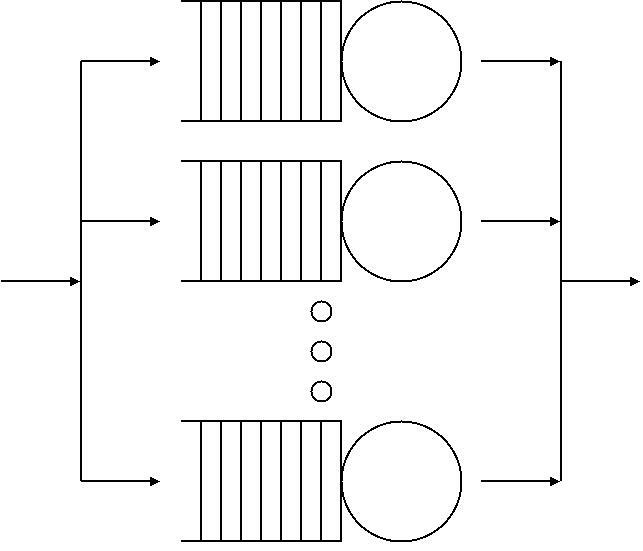
Queueing theory
Queueing theory is the mathematical study of waiting lines, or queues.[1] A queueing model is constructed so that queue lengths and waiting time can be predicted.[1] Queueing theory is generally considered a branch of operations research because the results are often used when making business decisions about the resources needed to provide a service.
"First come, first served" redirects here. For the Kool Keith album, see First Come, First Served.Queueing theory has its origins in research by Agner Krarup Erlang, who created models to describe the system of incoming calls at the Copenhagen Telephone Exchange Company.[1] These ideas were seminal to the field of teletraffic engineering and have since seen applications in telecommunication, traffic engineering, computing,[2] project management, and particularly industrial engineering, where they are applied in the design of factories, shops, offices, and hospitals.[3][4]
Spelling[edit]
The spelling "queueing" over "queuing" is typically encountered in the academic research field. In fact, one of the flagship journals of the field is Queueing Systems.
Description[edit]
Queueing theory is one of the major areas of study in the discipline of management science. Through management science, businesses are able to solve a variety of problems using different scientific and mathematical approaches. Queueing analysis is the probabilistic analysis of waiting lines, and thus the results, also referred to as the operating characteristics, are probabilistic rather than deterministic.[5] The probability that n customers are in the queueing system, the average number of customers in the queueing system, the average number of customers in the waiting line, the average time spent by a customer in the total queuing system, the average time spent by a customer in the waiting line, and finally the probability that the server is busy or idle are all of the different operating characteristics that these queueing models compute.[5] The overall goal of queueing analysis is to compute these characteristics for the current system and then test several alternatives that could lead to improvement. Computing the operating characteristics for the current system and comparing the values to the characteristics of the alternative systems allows managers to see the pros and cons of each potential option. These systems help in the final decision making process by showing ways to increase savings, reduce waiting time, improve efficiency, etc. The main queueing models that can be used are the single-server waiting line system and the multiple-server waiting line system, which are discussed further below. These models can be further differentiated depending on whether service times are constant or undefined, the queue length is finite, the calling population is finite, etc.[5]
In 1909, Agner Krarup Erlang, a Danish engineer who worked for the Copenhagen Telephone Exchange, published the first paper on what would now be called queueing theory.[9][10][11] He modeled the number of telephone calls arriving at an exchange by a Poisson process and solved the M/D/1 queue in 1917 and M/D/k queueing model in 1920.[12] In Kendall's notation:
If the node has more jobs than servers, then jobs will queue and wait for service.
The M/G/1 queue was solved by Felix Pollaczek in 1930,[13] a solution later recast in probabilistic terms by Aleksandr Khinchin and now known as the Pollaczek–Khinchine formula.[12][14]
After the 1940s, queueing theory became an area of research interest to mathematicians.[14] In 1953, David George Kendall solved the GI/M/k queue[15] and introduced the modern notation for queues, now known as Kendall's notation. In 1957, Pollaczek studied the GI/G/1 using an integral equation.[16] John Kingman gave a formula for the mean waiting time in a G/G/1 queue, now known as Kingman's formula.[17]
Leonard Kleinrock worked on the application of queueing theory to message switching in the early 1960s and packet switching in the early 1970s. His initial contribution to this field was his doctoral thesis at the Massachusetts Institute of Technology in 1962, published in book form in 1964. His theoretical work published in the early 1970s underpinned the use of packet switching in the ARPANET, a forerunner to the Internet.
The matrix geometric method and matrix analytic methods have allowed queues with phase-type distributed inter-arrival and service time distributions to be considered.[18]
Systems with coupled orbits are an important part in queueing theory in the application to wireless networks and signal processing.[19]
Modern day application of queueing theory concerns among other things product development where (material) products have a spatiotemporal existence, in the sense that products have a certain volume and a certain duration.[20]
Problems such as performance metrics for the M/G/k queue remain an open problem.[12][14]
Various scheduling policies can be used at queueing nodes:
Server failures occur according to a stochastic (random) process (usually Poisson) and are followed by setup periods during which the server is unavailable. The interrupted customer remains in the service area until server is fixed.[27]
Arriving customers not served (either due to the queue having no buffer, or due to balking or reneging by the customer) are also known as dropouts. The average rate of dropouts is a significant parameter describing a queue.


